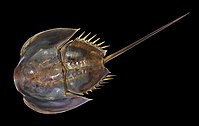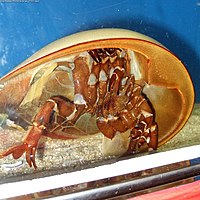Horseshoe crab
The horseshoe crab is a benthic or bottom-dwelling creature. It is not a crab at all, but a relative of the arachnids. Its main habitats are coastal areas and river estuaries.
| Horseshoe crab | |
|---|---|

| |
| Horseshoe crab | |
| Scientific classification | |
| Kingdom: | |
| Phylum: | |
| Subphylum: | |
| Class: | |
| Order: | |
| Family: | |
| Genus: | Limulus
|


Limulus polyphemus is the best-known of the four species.
Description
changeOn its dome-shaped carapace, the horseshoe crab has four small eyes. It has two compound eyes at the sides of the carapace, and two simple eyes on the front.
A horseshoe crab has twelve legs: five pairs of walking legs and a set of tiny pincers. The long, spiky tail is not used as a weapon or for defense; instead, it is just used for steering and flipping the body over if it gets turned upside down.
Distribution
changeAtlantic
changeAtlantic horseshoe crabs, Limulus polyphemus, can be found all over the eastern coast of North America and Mexico. Buried under mud or sand, they eat small clams, crustaceans, and worms. All over the coast, you will find their shells washed up on shore. Some of these shells are quite big, as the horseshoe crab can grow up to two feet long and a foot wide. Horseshoe crabs go through moults to reach that size.
The horseshoe crab population ranges from the Yucatán Peninsula to northern Maine, but they are most commonly found in the mid-Atlantic region between Virginia and New Jersey. Each major estuary along the coast has its own horseshoe crab population, distinguished from one another by size, colour and eye pigment. The females lay about 100,000 eggs.
Other species
changeThe other three species are also called horseshoe crabs.[1] The Japanese horseshoe crab (Tachypleus tridentatus) is found in the Seto Inland Sea, and is considered an endangered species because of loss of habitat. Two other species occur along the east coast of India: Tachypleus gigas and Carcinoscorpius rotundicauda.[2] All four are quite similar in form and behavior.
Status
changeHorseshoe crabs may be threatened by Asian overconsumption and by their use by pharmaceutical companies.[3] The tri-spine horseshoe crab, was listed as endangered by the International Union for Conservation of Nature in 2019. In 2023 BNP Paribas wrote to 14 of the world’s largest pharmaceutical companies asking them to use a cloned substance called recombinant factor C instead of blood from horseshoe crabs for tests. The Pharmaceutical Supply Chain Initiative, a lobby group set up by large pharmaceutical companies said its members should stop sourcing blood from the two Asian horseshoe crab species most at risk.[4]
Immune system
changeThe horseshoe crab has an effective immune system. Its brackish maritime environment is a perfect home for bacteria. The blood of horseshoe crabs contains an enzyme that causes very rapid clotting in response to the presence of infectious bacteria. This response is used by medical and pharmaceutical companies to detect those kinds of bacteria in products, before the products are sold.[5][6]
Origin
changeHorseshoe crabs are relatives of the Eurypterids (sea scorpions),[7] whose first fossils appeared at the same time. They are quite ancient. They were definitely present in the early Ordovician, 450 million years ago, in a Burgess Shale-type environment.[8] Their body shape has not changed much since then, though fossils in this group are scarce. The Atlantic horseshoe crab itself has no fossil record at all, and the genus Limulus goes back only some 20 million years, not 200 million.[9]
The order they belong to, the Xiphosura, are basal to a clade of the Eurypterida and the Arachnida.[10] It is estimated that the Xiphosura diverged from the Arachnida 480 million years ago.[11]
Evolution
changeBecause they are famous as so-called "living fossils", the evolutionary record and the genetics of the horsehoe crabs have been studied with interest.
- It is clear that there has been evolution and adaptation within the general body form.[12][13]
- From about 200 million years ago, little visible change took place. "Limulus... is morphologically very similar to forms that lived about 200 million years ago".[12] "The living species in the genus Limulus, are virtually identical to fossil species in a different family that existed 150 mya".[14]
- Genetic and molecular analysis of Limulus makes it clear that the animal has just as much genetic variability as any normal species.[15]
References
change- ↑ "The Horseshoe Crab natural history: crab species". Retrieved 2007-03-01.
- ↑ Basudev Tripathy (2006). "In-house research seminar: The status of horseshoe crab in east coast of India". Wildlife Institute of India: 5. Archived from the original on 2011-07-21. Retrieved 2011-03-07.
- ↑ BLUE BLOODS; The horseshoe crab is half a billion years old, but its existence may be threatened April 14, 2014 The New Yorker
- ↑ Smyth, Jamie; Temple-West, Patrick (2023-08-22). "Blue blood of horseshoe crabs puts pharma groups under scrutiny". Financial Times. Retrieved 2023-08-22.
- ↑ Ecological Research & Development Group. Medical uses
- ↑ Why are we 'milking' crabs for a coronavirus vaccine? BBC News
- ↑ Mikko Haaramo (2003). "Xiphosura - Horseshoe crabs". Mikko's Phylogeny Archive.
- ↑ Van Roy P. et al. 2010. Ordovician faunas of Burgess Shale type. Nature 465: 215–218. [1]
- ↑ Stephen Jay Gould (1989). Wonderful life: the Burgess Shale and the nature of history. New York: Norton. p. 43. ISBN 0-393-02705-8.
- ↑ Colin Tudge (2002). "Spiders, scorpions, mites, eurypterids, horseshoe crabs, and sea spiders. Subphylum Chelicerata and Subphylum Pycnogonida". The variety of life: a survey and a celebration of all the creatures that have ever lived. Oxford University Press. pp. 309–326. ISBN 9780198604266.
- ↑ Davide Pisani, Laura L. Poling, Maureen Lyons-Weiler & S. Blair Hedges (2004). "The colonization of land by animals: molecular phylogeny and divergence times among arthropods". BMC Biology. 2: 1. doi:10.1186/1741-7007-2-1. PMC 333434. PMID 14731304.
{{cite journal}}: CS1 maint: multiple names: authors list (link) - ↑ 12.0 12.1 Ridley, Mark 1996. Evolution. 2nd ed, Wiley-Blackwell, p574/5. ISBN 0-86542-495-0
- ↑ Newell N.D. 1959. The nature of the fossil record. Proc. Am. Phil. Soc. 103, 264–285.
- ↑ Freeman, Scott & Herron, Jon; 2000. Evolutionary analysis. 2nd ed, Prentice Hall, p526. ISBN 0-13-017291-X
- ↑ Avise J.C; Nelson W.S. & Sugita H. 1994. A speciational history of "living fossils": molecular evolutionary patterns in horseshoe crabs. Evolution 48, 1986–2001.